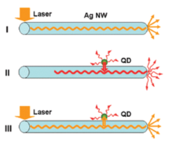Highlight
Electromagnetic interactions in hybrid metallic-semiconductor nanostructures
Achievement/Results
Graduate students Hong Wei and Daniel Ratchford working under the guidance of Hongxing Xu, Xiaoqin Li, and Chih-Kang Shih conducted research at the University of Texas at Austin to explore electromagnetic interactions in hybrid metallic-semiconductor nanostructures. Such nanostructures offer versatile functionality and have broad applications in fields such as quantum information, nanophotonics, single molecule spectroscopy, and solar energy harvesting.
When light interacts with metallic nanowires, the light can be concentrated into an intense electromagnetic field that propagates along the surface of the nanowire. Such an excitation is referred to as a propagating surface plasmon. Interactions between propagating surface plasmons and fluorescent emitters are of great interest, as these interactions allow for nanostructures with tunable optical properties.
Interactions between nanoscale metallic and semiconductor components may allow for integrated and tunable optical properties, but these interactions can be complex and are not fully understood. Fundamental research on simple nanostructures is still needed in order to guide the design and utilization of these structures for applications. In particular, the research conducted by this group addressed basic questions regarding the direction of energy transfer between silver nanowires and semiconductor quantum dots (fluorescent nanoparticles).
The findings of this research were summarized and published in the article Propagating Surface Plasmon Induced Photon Emission from Quantum Dots in the journal Nano Letters (2009 Vol 9(12) 4168-4171). Experimental results showed the energy exchange in the nanowire-quantum dot system was bidirectional. As illustrated by the cartoon in fig. 1, surface plasmons traveling along a nanowire excited nearby quantum dots, and vice versa, excitation of the quantum dots generated propagating surface plasmons in the nanowire.
Using a home-built inverted microscope, a laser beam probed the nanowire-quantum dot system (see fig.2). Fig. 3 summarizes the results of the study. In fig. 3d, the laser optically excited a group of quantum dots. Through energy transfer from the quantum dots to the nanowire, propagating surface plasmons were generated along the nanowire. This can be inferred from the light that radiated out the ends of the nanowire. The reverse process is shown in Fig. 3e-f. Laser excitation of a propagating surface plasmon caused the emission of light from the quantum dots located along the nanowire.
These results describe a fundamental insight in the energy transfer process in this metallic-semiconductor system: the energy transfer process is bidirectional. This has important implications for technology development in such fields as nanophotonics and solar energy harvesting where there is a desire to integrate semiconductor and metallic nanostructure components.
Address Goals
The field of nanoscience is large and diverse, and because of the promise it holds for transformational technologies, it is only getting larger. As a result, high impact research often requires collaborations between diverse research groups. Members of a collaboration can bring their unique skill sets to the research which allows the group to tackle problems they could not address alone. Furthermore, because of the growth of this field, it is becoming increasingly necessary to foster collaborations among research groups in different countries.
This NSF-funded research was only made possible through an international collaboration. Hong Wei, a chemistry student from the Beijing National Laboratory for Condensed Matter Physics and Institute of Physics, came to The University of Texas at Austin and worked with Daniel Ratchford, a physics graduate student. The advanced facilities located at The University of Texas at Austin gave the group access to the necessary experimental equipment (e.g. chemical vapor deposition and versatile optical setup with tunable Titanium-sapphire laser) to complete this study. The groups’ varied backgrounds in plasmonics along with the access to advanced equipment made this collaboration particularly well suited to address the research of electromagnetic interactions in hybrid metallic-semiconductor nanostructures.








